9 best drops from conjunctivitis
The conjunctiva is a thin, almost transparent connective sheath that passes from the surface of the eyeball to the inner surface of the eyelids. Each, having pulled back his lower eyelid, can see the conjunctiva in the form of a transitional fold. The conjunctiva not only allows the eyeball to move freely, it produces various secrets, such as mucin and tear fluid. The human conjunctiva is exposed to environmental factors, especially during the period of active wakefulness. But she gets dust, it blows the wind, annoying bright light. Therefore, the deep layers of the conjunctiva perform an immune function, protecting the eyeball from the effects of these factors.
It is known that almost a third of all eye diseases are a variety of conjunctivitis, that is, inflammation of this shell. And among the inflammatory pathology of the eye and its appendages, conjunctivitis accounts for more than 65% of all diseases. The most common bacterial and viral inflammatory lesions of the conjunctiva, less often the cause is allergy and dystrophic processes.
Most often, acute inflammation of the conjunctiva occurs in children, in adults it occurs much less frequently, but it is more difficult to bear. There are also chronic conjunctivitis, which often occur in old age, and in adults of working age often have a professional nature, and occur under the influence of harmful production factors.
In the treatment of conjunctivitis are used a variety of ways, but the most effective is the local administration of drugs in the conjunctival sac in the form of drops and washes. This rating includes drugs intended for instillation in the conjunctiva, which are used in both adults and children.
What is the principle of this droplet rating for treating conjunctivitis? It is known that childhood diseases are almost always treated with the same drugs as diseases in adults. It is unlikely that even an experienced pediatrician will find a medicine that is used only in children, but never used in adult patients. It's all about the age limit. The same drug, only in different concentrations, can be used in both adults and children. And it will not be a different medicine, since the same substance will be active.
Therefore, in this rating of drugs in drops for the treatment of conjunctivitis in children, those drugs that can be prescribed from an early age will be considered. The adult “drops” will include all other representatives, the appointment of which, as a rule, is possible from the age of 6 or 12 years. Therefore, most drops for the treatment of conjunctivitis in adults, is also used in adolescents (with the exception of NSAIDs).
Important rules for the treatment of conjunctivitis
Typical symptoms of acute conjunctivitis are stinging and itching in the eye, the presence of copious mucous or purulent discharge from the conjunctiva, which usually accumulates in the corners of the eyes.In some cases, photophobia occurs. The conjunctiva of the eyelids and transitional folds are swollen, the eye usually appears red due to vascular injection. If you pull the lower eyelid, you can see mucopurulent or purulent discharge, which must be washed and removed. When these symptoms appear, you should immediately contact an ophthalmologist, since a complication of conjunctivitis may be a transition of inflammation to the eyeball and even complete loss of vision. When treating at home it is very important to observe the following rules:
- In the event that an ophthalmologist prescribed you or your child drops for the treatment of conjunctivitis, they should be begun to be instilled only when the secretion of mucous or purulent discharge has stopped. With acute conjunctivitis and the presence of abundant discharge in no case be sure to cover the eye with a bandage! In the acute form of conjunctival inflammation, the first use is washing with various antiseptic solutions. These include a weak solution of potassium permanganate, a decoction of strong tea, chlorhexidine, Furacilin or Miramistin;
- if there is no heavy tearing, then you need to dig in each conjunctiva (conjunctival sac) with only one drop. This volume is quite enough for the complete distribution of the medicinal substance, and two drops is a marketing ploy of the manufacturer;
- if eye irritation and excessive tearing is observed, then after 30 minutes the drug, dripped into the eye, is already washed out. In that case, if we are talking about an acute purulent inflammatory process, then such a rare instillation and low concentration of the drug in the eye can lead to the development of drug-resistant pathogen. Therefore, in the case of purulent inflammation of the conjunctiva, it is necessary to dig in no less than an hour later, and ideally, as often as advised;
- at night, when the eyeball is closed by closed eyelids, favorable conditions for the development of the microbial flora begin to be created inside the conjunctival cavity. The result will be bonding of the eyelids in the morning and the impossibility of “opening the eyes” in the literal sense. At bedtime, it is advisable to put ointment into the conjunctiva, for example, tetracycline eye ointment. It is very slowly absorbed, and will allow you to open your eyes in the morning, painlessly and calmly. During the day, it is not recommended to prescribe ointment: it will simply interfere with vision, and make the world around us foggy.
Now, after the patient knows what to do and what not to do with conjunctivitis, the most popular and effective eye drops for the treatment of conjunctivitis in adults and in children will be described. Various drops will be presented, which are used for allergic conjunctivitis, viral processes and bacterial. The rating also includes anti-inflammatory drops that do not eliminate the cause, but reduce the manifestation of the inflammatory process (edema, redness, pain and sting), are used as a means of pathogenetic treatment and significantly improve the quality of life. Finally, various antiseptic preparations that clean the conjunctival cavity will be presented. It is enough to provide one drug in drops from each group for the treatment of conjunctivitis in adults and in children.
Top conjunctivitis drops
| Nomination | a place | Name of product | price |
| The best conjunctivitis drops for adults | 1 | Vizin-Alergi, Histimet (Levocabastine) | 340 ₽ |
| 2 | Aktipol (aminobenzoic acid) | 320 ₽ | |
| 3 | Cipromed (ciprofloxacin) | 132 ₽ | |
| 4 | Montevisin, Vizin Classic, Octilia (tetrisoline) | 160 ₽ | |
| 5 | Okomistin | 180 ₽ | |
| The best drops of conjunctivitis for children | 1 | Lecrolin, Cromohexal (cromoglycic acid) | 98 ₽ |
| 2 | Ophthalmoferon (interferon + diphenhydramine) | 260 ₽ | |
| 3 | Levomycetin | 15 ₽ | |
| 4 | Ocmetilized | 250 ₽ |
The best conjunctivitis drops for adults
This section included those drugs in drops for treating various forms of conjunctivitis, which have age limits and are not used in infants and in children up to 3-5 years of age. In the description of each drug will be specified the minimum age at which to start to drop these drops. First, anti-allergic drugs will be considered, then drops in case of viral conjunctivitis, bacterial damage, anti-inflammatory drugs and, finally, disinfectants or antiseptics.
Antiallergic: Vizin-Allergy, Histimet (Levocabastine)
Rating: 4.9
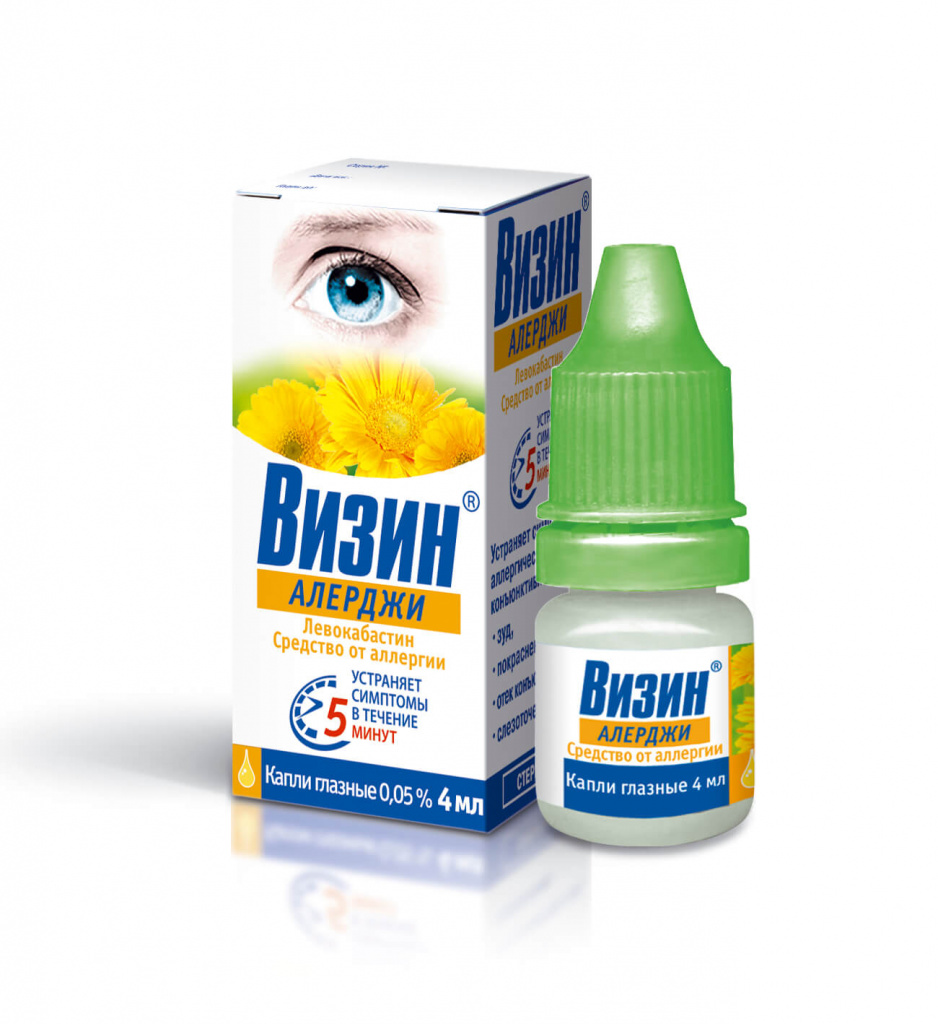
Vizin-Alergi, or levocabastin, is a modern antiallergic agent in drops for the treatment of various forms of allergic conjunctivitis. The classic signs of such a process will be pronounced itching, redness and swelling of the conjunctiva, the rapid development of tearing. Quite often, allergic conjunctivitis develops when exposed to respiratory allergens, with the flowering of various herbs, with food allergies.
Drops are a white suspension of uniform composition, and the active substance is a selective, or selective blocker of H1 - histamine receptors. Levocabastin acts quickly and for a long time. Within 5 minutes after instillation, the above signs of allergic conjunctivitis are reduced, and the remedy lasts up to 12 hours.
This drug can be used in adolescents who have reached the age of 12, as well as in adult patients. The remedy is contraindicated in nursing mothers. It is necessary to instill in each conjunctival sac, having previously pulled back the lower eyelid, one drop twice a day (maximum 3-4 drops in 12 hours). Treatment should be continued until the symptoms listed above diminish or disappear. Vizin Allerji is produced by the Greek company Tamar, and one 4 ml bottle can be purchased at pharmacies in major cities of the Russian Federation in early 2024 at an average price of 340 rubles per bottle.
Advantages and disadvantages
The advantage of this drug is fast action, good tolerability, and with non-severe forms (for example, without the development of angioedema), the ability to manage with just two drops per day, which is very convenient. The means are well tolerated, and only in rare cases was irritation of the eyes, as well as blurred vision. However, since this drug can have a systemic effect, then overdose, especially if 6 drops are dropped into the eye and more often, which is completely unacceptable, there can be such systemic manifestations as a drop in blood pressure, sedation, or retarding effect, an increase in heart rate. But in the event that this drug is prescribed quickly and according to indications, it significantly improves the quality of life, and sometimes it just saves, for example, the driver, an allergic person, passing through a blooming field. Therefore, patients with an increased allergic background need to have on hand these or similar eye drops.
Antiviral: Actipol (aminobenzoic acid)
Rating: 4.8
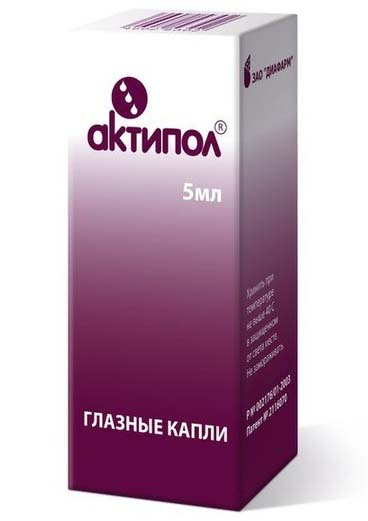
Domestic antiviral and immunomodulatory drug Actipol contains the only active ingredient - aminobenzoic acid. This agent is not directly antiviral, these drops cannot be compared in effectiveness with real antiviral agents, for example, eye ointment acyclovir, or Zovirax. But since this rating involves the use of only drops, Aktipol can be used in complex therapy as an inducer of endogenous interferon. It is known that increased production of interferon has an antiviral effect, obtained with the help of the body's own defenses.
With local penetration of the droplets into the conjunctival sac, aminobenzoic acid is very rapidly absorbed.Actipol has been shown in the complex therapy of various viral conjunctivitis and keratoconjunctivitis, which, first of all, have a herpetic nature. It is necessary to dig in one drop quite often, from 3 to 8 times a day. At night, it is recommended to use a combination with antiviral eye ointments. The tool does not apply to pregnant women, nursing mothers, in persons under the age of 18 years. This clause in the instructions is typical for many domestic companies that do not spend money on testing the efficacy and safety of drugs in such categories of patients.
Produces the drug Aktipol domestic pharmaceutical company Diafarm, and packaging volume of 5 ml (0.007%), will cost an average of 320 rubles.
Advantages and disadvantages
The disadvantage of this drug is the fact that only in combination with specific antiviral drugs, it leads to a rapid decrease in complaints. If it is used alone, then the period of activation of endogenous interferon is sometimes simply not enough to cope with a viral infection, especially if the patient has reduced immunity. The cost of this drug is very high, especially considering that there will be no significant improvement over the first few days of use. But still, if Actipol is used in complex treatment, then the effect of clinical recovery will be faster, and if this remedy is used in conjunctival dystrophic processes, as an auxiliary drug in the treatment of eye fatigue, while wearing contact lenses, with such a preventive purpose Aktipol successfully applied.
Antibacterial drops: Cipromed (ciprofloxacin)
Rating: 4.8
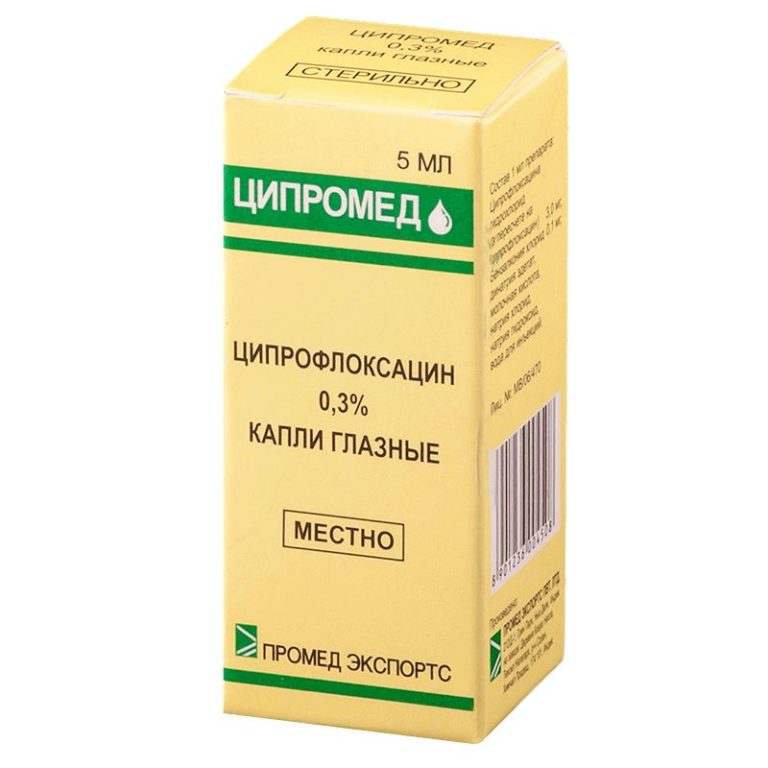
There are a large number of different antibiotics in the drops, including effective ones, but if they drip for every reason, then the microbes will develop endurance, or resistance. Let them remain the reserve funds, and are appointed by the ophthalmologists taking into account the bacterial flora. Therefore, we consider widely used and still quite effective antibacterial drops - Cypromed, containing the first generation fluoroquinolone - ciprofloxacin.
This drug has the best effect on gram-negative microflora, such as E. coli, salmonella, shigella, enterobacter, but also inhibits gram-positive pathogens - staphylococci and streptococci. When the local destination drops, they quickly penetrate into the eye tissue. Cypromed is shown in all forms of acute microbial purulent conjunctivitis, of course, after a preliminary period of washing the conjunctiva and removing the purulent discharge.
This remedy is indicated for keratitis, uveitis, eyelid inflammations, or blepharitis. This remedy is contraindicated in case of hypersensitivity, during pregnancy, lactation. Ciprofloxacin drops not used in children under the age of one year.
It is necessary to apply Tsipromed, burying it one by one - two drops in each conjunctival sac, with an acute bacterial process - from 4 to 8 times a day. In that case, if we are talking about keratitis, that is, damage to the cornea, the drug is instilled at least 6 times a day. Cipromed is manufactured by Indian company Sentiss Pharma, and a package of 5 ml drops can be purchased at an average cost of 132 rubles, which is very inexpensive.
Advantages and disadvantages
The advantage of Tsipromed is a large spectrum of antibacterial action, and good tolerability. On the other hand, it should not be used when wearing contact lenses, because it contributes to increased infection. Recall that in general, in the presence of an inflammatory process, it is urgent to abandon any form of contact vision correction. This drug is inexpensive, but its effectiveness is not so high, and therefore requires fairly frequent use.In addition, immediately after the instillation of the funds in the eyes, there may be some blurred vision, and therefore after the instillation you should not get behind the wheel. Of course, in the case of conjunctivitis with severe symptoms, such as lacrimation and photophobia, gets behind the wheel, and working with mechanisms in general is strictly prohibited.
Montevisin, Vizin Classic, Octilia (tetrisoline)
Rating: 4.7
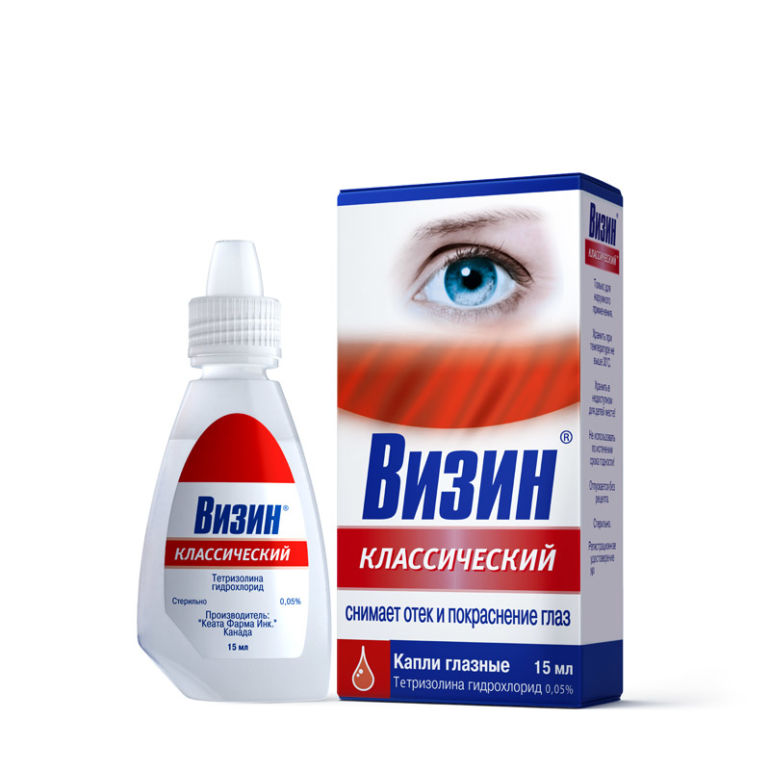
Montevizin, or tetrizolin, is considered a vasoconstrictor drug, which belongs to the class of alpha adrenergic mimetics, and just like the ancestor of all these drugs, adrenaline, it is able to constrict blood vessels. As a result of this effect of vasoconstriction, swelling decreases, hyperemia decreases, that is, vascular injection of the sclera and redness of the eyeball, and irritation symptoms decrease.
Montevizin need to drip one to two drops in each conjunctival sac no more than 3 times a day. In addition to conjunctivitis, this drug is indicated for use in tired eye syndrome, dry eyes, and various irritating aerosols, such as dust or cigarette smoke. Montevizin will be used by adults after swimming, after intense visual loads that cause red eyes: driving a car or intense work at the computer.
This tool can not be used in patients under six years of age, pregnant women, nursing mothers, adult patients suffering from glaucoma and corneal dystrophy. There is also a list of relative contraindications, so only a doctor should prescribe a drug. These include thyrotoxicosis, diabetes mellitus, and damage to the cardiovascular system. The cost of packaging in 10 ml of Montevizin eye drops is, on average, 160 rubles, and the Yugoslav Hemofarm campaign produces them.
Advantages and disadvantages
The great advantage of this drug is the absence of addiction, as well as a reduction in the symptoms of inflammation without the use of corticosteroid hormones. Montevizin is an inexpensive, and fast-acting drug. However, the effect of its use is not as fast as, for example, when using levocabastin for allergic conjunctivitis. It is considered that the duration of action does not exceed 8 hours. A drug, like any adrenomimetic, with an increase in the daily dose may, on the contrary, cause an increase in the symptoms of conjunctivitis. This is a burning sensation in the eye, tearing, the patient dilates the pupil (mydriasis), and with an overdose, tachycardia appears, and an increase in blood pressure.
Okomistin
Rating: 4.7
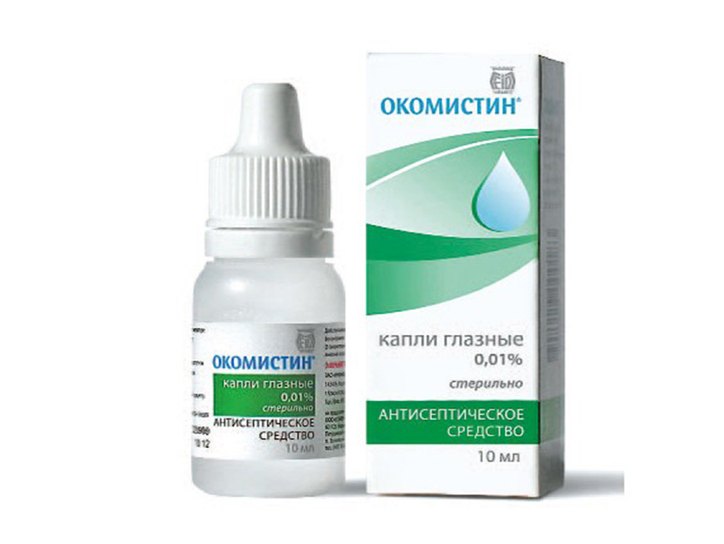
Okomistin (benzyldimethyl-myristoylamino-propylammonium) is a wonderful agent that exhibits high antiseptic properties. This domestic invention is a very effective antiseptic, which is known as Miramistin. It is used in large volumes for washing eyes, for surgical treatment of wounds, for gargling, for urgent prevention of sexually transmitted diseases, for treatment of burn surfaces, for creating coatings on patches and so on.
In this case, these are really effective antiseptic eye drops that can be used in the most diverse pathologies of viral-bacterial, fungal or protozoal origin.
Apply Okomistin need one or two drops in each conjunctival sac up to 6 times a day, for therapeutic purposes. This tool can be used in adults and in children. Okomistin can be used in pregnant and lactating women. Therefore, Okomistin can be safely attributed to the universal remedy for the treatment of conjunctivitis, both for children and for adults. Infamed company produces these drops, and there is a pack in 10 ml, on average, 180 rubles.
Advantages and disadvantages
The appearance of Okomistin as a separate “miramistina for the eyes” is an excellent marketing ploy: only 10 ml of these drops cost 180 rubles. (0.01% solution).If we buy a bottle of simple Miramistin for the same purpose, then a bottle of 50 ml will cost only 163 rubles. The concentration of the active substance in both cases is the same.
Therefore, you yourself should decide whether to buy a vial of Miramistin and bury it in your eyes, or to purchase the same Miramistin in the same concentration, but specifically positioned as “eye drops”. In the first case, you will save, and in the second - pay five times more. As for efficiency and safety, Miramistin is an excellent tool.
The best drops of conjunctivitis for children
Children's remedies in drops from conjunctivitis are drugs with advanced indications for use in toddlers. The effectiveness of children's drops is about the same, but the safety requirements are much higher, because the children's body has other indicators of metabolic rate, and the drug should not accumulate, or accumulate in the body, and also enter it in too large a dose. Consider the most effective and safe drops for the treatment of conjunctivitis in children in the same sequence: from anti-allergy drugs to anti-inflammatory drugs. As for antiseptic drops, then perhaps the best choice would be the same Miramistin, described in the previous section.
We need to give advice: how to bury drops in the eyes of children. Children are not adults, and if they drip too cold drops, they can then be capricious. Therefore, it is necessary to first check the temperature of the drops, causing them on the back of the hand, near the wrist, or simply leaning a bottle of drops against the skin. If there is no thermal sensation, then it means that such drops can be dripped to the baby. If it is necessary to drip drops into a child before going to sleep or already sleeping, then such a warm drop will not cause his awakening. It is enough just to raise the eyelid during sleep and gently apply the drug there.
Antiallergic: Lekrolin, Cromohexal (cromoglycic acid)
Rating: 4.9
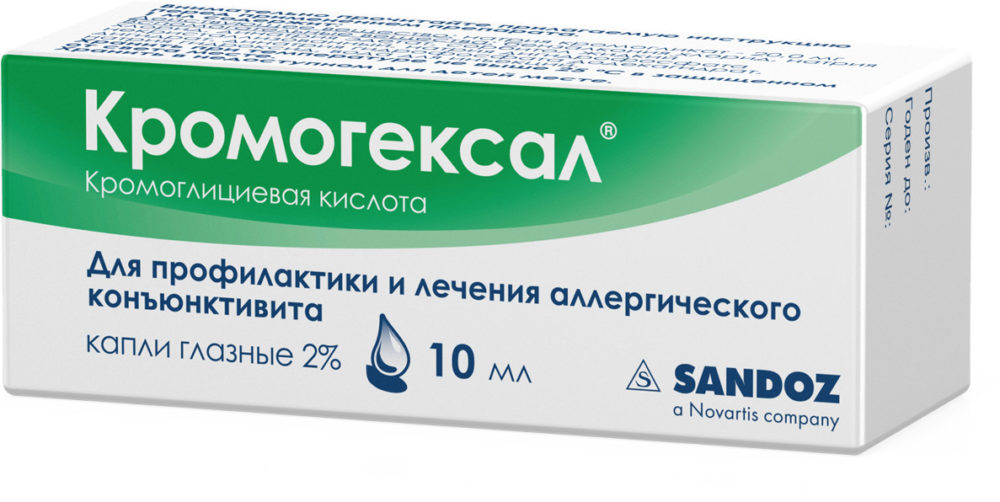
This tool is used in ophthalmology, including in the nursery, as an anti-allergy drug only: cromoglycic acid stabilizes the membranes of mast cells and prevents the release of biologically active amines, primarily histamine and bradykinin, which realize allergic effects. The use of Lekrolina can significantly reduce symptoms such as intense itching in the eye, severe redness and discharge of tears.
However, it must be remembered that in its pure form allergic conjunctivitis in babies occurs rarely, and even more so in this stage that it is necessary to use special drops. It is enough to change the diet of a nursing mother, or to delay the introduction of the complementary food that could cause these unpleasant symptoms. Therefore, in the first place such a baby must be shown to the pediatrician.
In the same case, if Lecrolin eye drops are prescribed, it should be remembered that the full clinical effect occurs within a few days or even a few weeks after application. This tool can be dripped to babies of any age, but those who are not yet four years old should use it with caution.
Instill need 1 to 2 drops in each conjunctival sac 3 to 4 times a day. Pharmaceutical company Santen from Finland produces these eye drops, and their cost is low: you should pay only an average of 98 rubles per 10 ml bottle.
Advantages and disadvantages
The advantage of Lecrolin is its greatest safety of all antiallergic drops that can be used in children. Most of them have age restrictions, and do not apply to children earlier than 6 years, and some - and at a later age. This tool is inexpensive and reduces the need for dosage of hormone containing drops, if they are assigned to a child.But at the same time, Lecrolin has some side effects. These include a quickly passing foreign body sensation, fuzziness, and even burning in the eye. Therefore, it is necessary to use this drug as short as possible, and first of all try to eliminate the allergization of the baby.
Antiviral: Ophthalmoferon (interferon + diphenhydramine)
Rating: 4.8
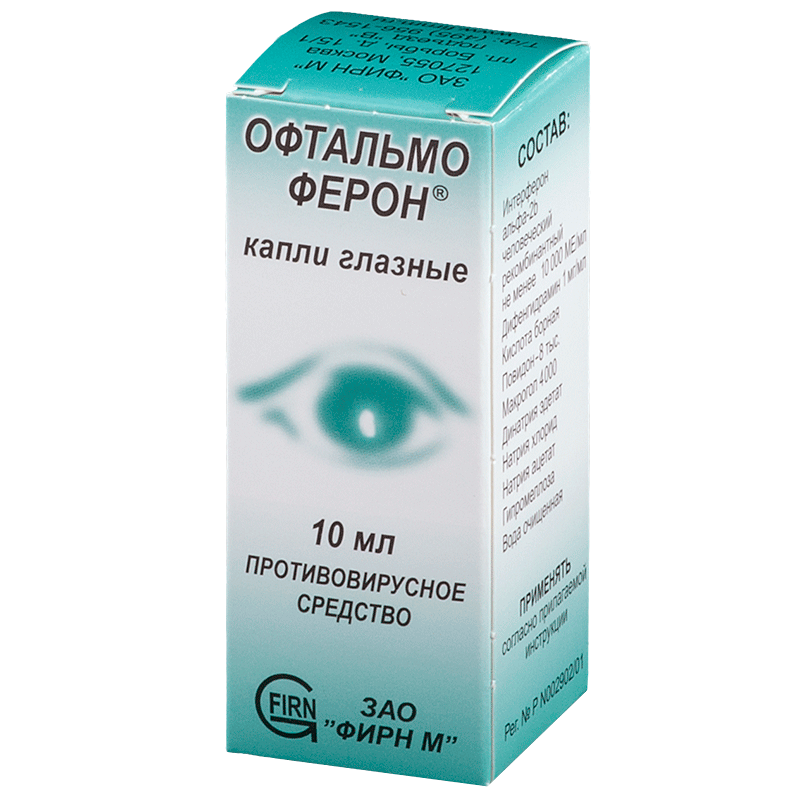
These eye drops are bicomponent. They contain synthetic interferon, which has antiviral effect and is related to cytokines, as well as a histamine receptor blocker. Therefore Ophthalmoferon has not only antiviral and immunomodulatory effects, but also reduces itching in the eyes, reduces signs of allergy, swelling. It helps with many infectious and viral lesions of the conjunctiva, for example, for herpetic eye disease. It is used with the appointment of one or two drops in each conjunctiva up to 8 times a day. The course of treatment may not be very long, on average, for 10 days. These drops are produced by the domestic manufacturer ZAO Firn, and the cost of a 10 ml bottle containing 10,000 units of interferon per milliliter, on average, is 318 rubles.
Advantages and disadvantages
The advantage of this drug is a complex composition, and the removal of symptoms associated with conjunctivitis, both infectious and allergic. However, one should be cautioned against the sole purpose of such a drug as monotherapy for accurately diagnosed conjunctivitis of herpes etiology. It is known that ophthalmic herpes, or herpetic eye disease, is very dangerous, and can lead to high mortality encephalitis, as well as blindness.
Therefore, Ophthalmoferon can, in the case of ophthalmic herpes, be used only in complex therapy, when, in the first place, truly antiviral drugs with proven effectiveness are used, for example, such as Zovirax or its analogues. In this case, antiviral therapy will involve the application of eye ointment, as well as the use of tablets inside. In the same case, If Ophthalmoferon is used as a means of prevention, for example, in the same allergic conjunctivitis, then it may well cope with mild symptoms in a child.
Antibacterial: Levomitsetin
Rating: 4.8
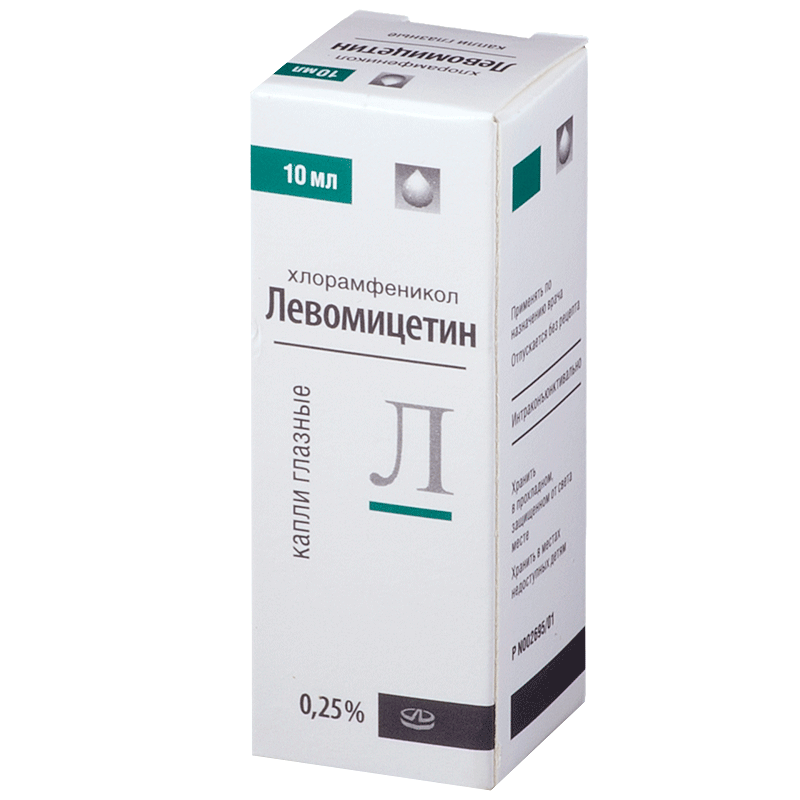
It is not surprising that we recommend using chloramphenicol in the rating, and not any other antibacterial drops. The fact is that chloramphenicol is one of the most widely used, safe antibiotics for treatment, including conjunctivitis, which allows you to quickly stop the progression of symptoms. If you apply stronger means, they can blur the clinical picture, and cause the development of microbial resistance.
And it is not recommended to use Albucid, or sulfacyl-sodium, especially in young children. The fact is that it causes a very strong burning sensation in the eye, and after the first instillation it will be very difficult for you to attract the baby to further treatment. We can assume that Albucid is the means that destroys the child's adherence to treatment. And chloramphenicol in this respect is calmly tolerated and does not cause burning. It can be applied in each conjunctival sac as well, every 30 minutes, and in the event that a more serious antibacterial drug is needed, a doctor will prescribe it. Chloramphenicol eye drops are the leaders in cheapness. One bottle of 10 ml of domestic production (Pharmstandard) will cost only 15 rubles.
Advantages and disadvantages
Both advantages and disadvantages are obvious. This drug is well tolerated, it is safe, it can be buried in the eyes of children as many times as necessary, it is used even in maternity hospitals and has an extremely low and attractive price.On the other hand, alone, he is unlikely to be able to cope with severe microbial inflammation of the conjunctiva, because resistance to it often develops, because this drug has been used for a long time. But as a means that from the very first day of conjunctivitis can prevent the progression of the infection, being safe is the value of chloramphenicol drops.
Anti-inflammatory: Ocmetil
Rating: 4.7
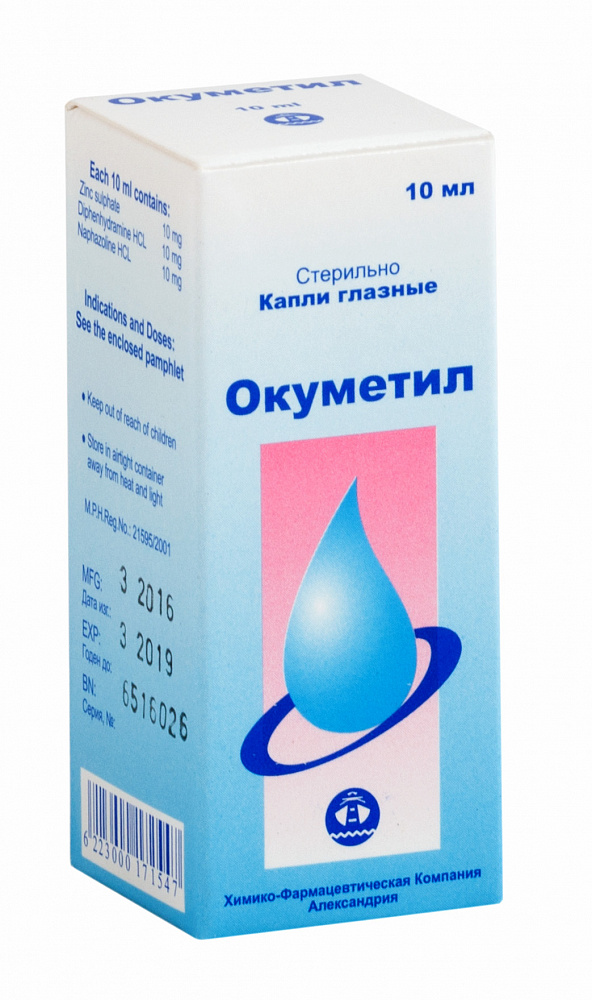
It is a combination drug that contains the antiallergic component diphenhydramine, vasoconstrictor naphazoline, which is better known as Naphthyzinum, and astringent zinc sulfate. Okumetil is indicated for various conjunctivitis, which occur in chronic and acute form and are not caused by microbial flora, as well as viruses. It is indicated for use in allergic conjunctivitis and blepharitis in children.
Ocmetil helps with eye irritation, sensation of redness and itching, and sensation of a foreign body in the eye. Of course, children very rarely develop chronic conjunctivitis, so this remedy is mainly indicated for adults, but a very important fact is that the official instruction allows children who have reached the age of two to use this drug.
Apply this tool is necessary in one drop in each conjunctival sac from 2 to 3 times a day. If there is no relief within three days, then it is necessary to stop treatment and be sure to contact a pediatric ophthalmologist. Okumetil is made by the Egyptian company Alexandria, and the average cost per bottle-dropper with a volume of 10 ml is 250 rubles.
Advantages and disadvantages
Dignity Okumetila - the ability to appoint him since two years. This indication is quite rare, usually anti-inflammatory drops, for example, are not assigned to children from the group of NSAIDs, but you can read on the Internet that such drops as Diclofenac (Diclo-F) or containing indomethacin can be used freely in a child . Such drops can be prescribed only to persons after the age of eighteen. In the best case, the instructions for the funds from this group will say that “it is necessary to use it in childhood with caution”. Hormonal drugs in drops can very quickly reduce the symptoms of inflammation, but they can be used in a child strictly after prescribing an ophthalmologist. Therefore, a drug such as Ocmetil, can be considered one of the best for the use of a short course, and be considered as an “eye first aid,” including in children. However, it does not contain hormones and antibiotics, so its use does not “smear” the picture of inflammation, and it does not hurt to make a correct diagnosis.
Attention! This rating is subjective, is not advertising and does not serve as a guide to the purchase. Before buying, you should consult with a specialist.













